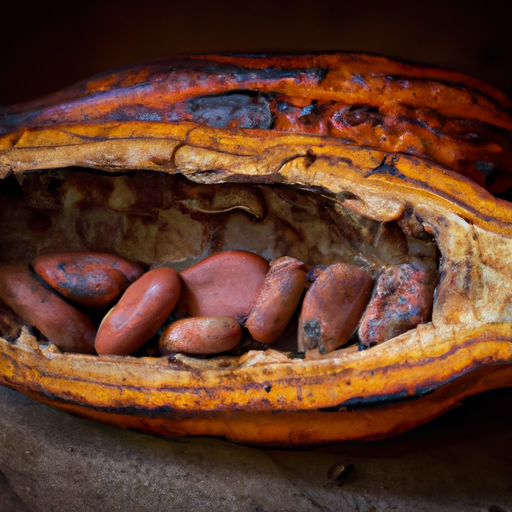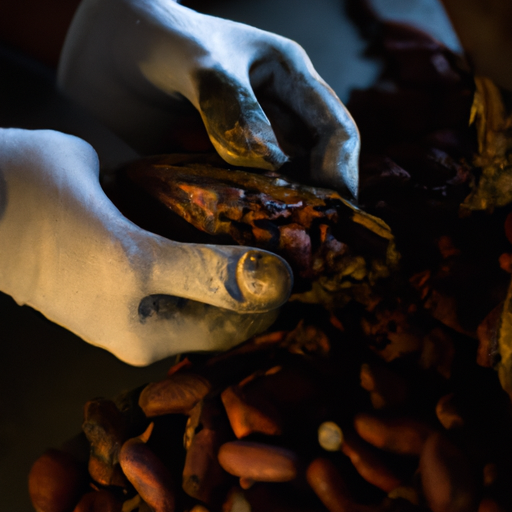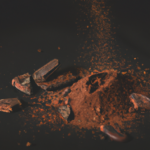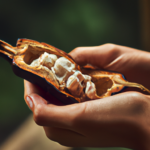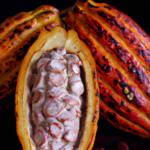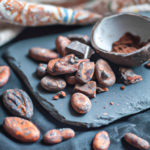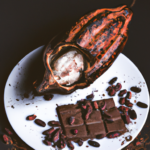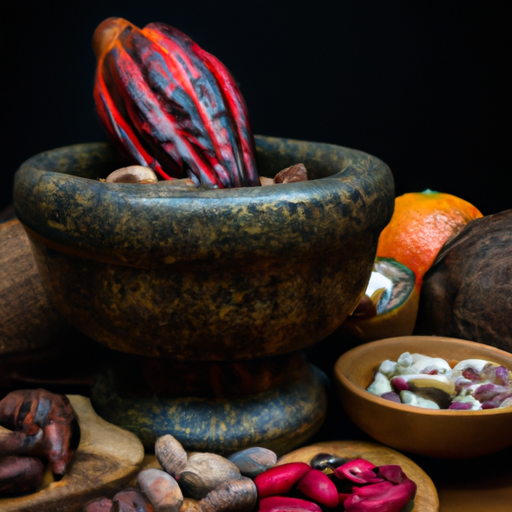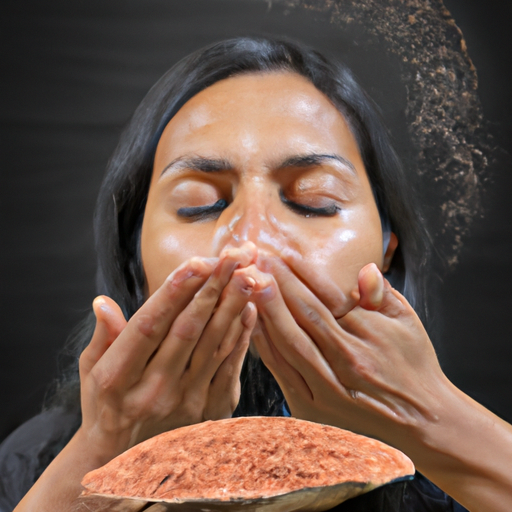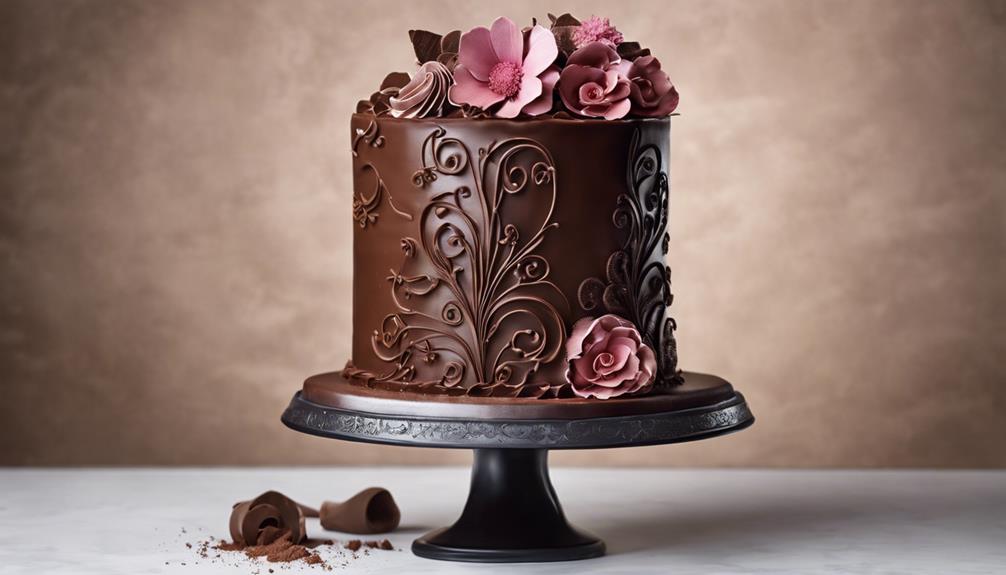Have you ever thought about what pure indulgence really is? Allow me to guide you on an exploration of the enchanting world of raw cacao. Get ready to treat your senses as we delve into the look, feel, color, scent, and flavor of this heavenly ingredient.
Raw cacao, derived from the cacao tree, is a treasure trove of delight for the senses. Its beans, with their rich mahogany hue, are an irresistible sight, beckoning you to experience their velvety smooth texture. Crushed into a fine powder, raw cacao takes on a deep, dark earthy tone, ready to be transformed into delectable creations. And let’s not forget the heavenly aroma of raw cacao butter, which can transport you to chocolate paradise with just a whiff.
But it’s not just about the looks and aroma – raw cacao delivers a taste that is truly unparalleled. Whether in the form of buttery smooth paste or crunchy nibs, each bite will leave you craving for more.
So, join me as we dive into the world of raw cacao and unlock its secrets. Get ready to elevate your culinary experience to new heights with this extraordinary ingredient.
Key Takeaways
- Raw cacao has a visually appealing rich mahogany hue and can be transformed into a fine powder with a deep, dark earthy tone.
- Raw cacao beans are small, oval or elongated in shape and have a deep brown to reddish hue. They are packed with antioxidants and minerals like magnesium, iron, and calcium.
- Raw cacao powder has a smooth, velvety texture and adds a rich, chocolatey taste to baked goods and desserts. It also provides numerous health benefits.
- Raw cacao butter has a rich and intoxicating aroma and is moisturizing and nourishing for the skin. It can be easily made at home by extracting natural fats from cacao beans.
The Origin of Raw Cacao
If you’ve ever wondered where the rich and decadent flavor of raw cacao comes from, you’re in for a fascinating journey into the origins of this delectable treat.
The history of raw cacao cultivation traces back thousands of years to the ancient civilizations of Mesoamerica. Cultivated primarily by the Mayans and Aztecs, raw cacao held immense cultural significance. It was not only used for consumption but also played a role in religious ceremonies and was considered a sacred gift from the gods. The Mayans even used cacao beans as currency in their trade.
The cultural significance of raw cacao consumption continues to this day, with its association to indulgence, pleasure, and celebration.
Now, let’s dive into the appearance of raw cacao beans.
The Appearance of Raw Cacao Beans
Imagine yourself holding a handful of these little nuggets of chocolate magic, with their rough, knobbly exteriors and deep, rich color that’s begging to be transformed into a decadent treat. Raw cacao beans are truly a sight to behold. They have an organic, natural look that reflects their untouched state. The beans themselves are small, roughly the size of a cherry, and are usually oval or elongated in shape. Their color can vary from a deep brown to a reddish hue, giving them an earthy and vibrant appearance. In terms of their health benefits, raw cacao is packed with nutrients. It is a great source of antioxidants, which can help protect the body against damage from free radicals. Additionally, raw cacao beans are rich in minerals such as magnesium, iron, and calcium. These minerals are essential for maintaining a healthy body and supporting various bodily functions. With their impressive nutritional value, raw cacao beans are not only visually appealing but also highly beneficial for our well-being. In the next section, we will explore the texture of raw cacao powder.
The Texture of Raw Cacao Powder
Hold a handful of raw cacao powder and feel its smooth, velvety texture that’s ready to be transformed into a delectable treat.
Raw cacao powder is made by grinding raw cacao beans, resulting in a fine, powdery substance. This texture is perfect for mixing into smoothies, baking, and creating delicious chocolate desserts.
Raw cacao powder is a versatile ingredient that can be used in a variety of ways to enhance both the flavor and nutritional value of your dishes. Not only does it add a rich, chocolatey taste, but it also provides numerous health benefits.
Raw cacao powder is packed with antioxidants, minerals like magnesium and iron, and natural mood-boosting compounds. Its texture allows it to easily blend into foods, providing a smooth and creamy consistency.
Transitioning into the subsequent section about the color of raw cacao nibs, the texture of raw cacao powder is just the beginning of its appeal.
The Color of Raw Cacao Nibs
The color of raw cacao nibs is as rich and deep as a dark mahogany wood. It’s a mesmerizing sight to behold, with its intense, dark brown hue. But the beauty of raw cacao nibs goes beyond its appearance. These little nuggets of goodness are packed with numerous health benefits. Rich in antioxidants, raw cacao nibs can help promote a healthy heart and reduce the risk of chronic diseases. They are also a great source of minerals like magnesium and iron, which are essential for maintaining proper bodily functions. Additionally, raw cacao nibs have been known to have benefits for the skin, thanks to their high levels of flavonoids and antioxidants. So not only do raw cacao nibs look amazing, but they also offer a range of health benefits. Moving on to the next topic, let’s explore the enticing aroma of raw cacao butter.
The Aroma of Raw Cacao Butter
Indulging in the aroma of raw cacao butter is like being enveloped in a warm, decadent embrace that transports you to a world of pure bliss. The scent is rich and intoxicating, with hints of chocolate and a subtle earthiness.
But the benefits of raw cacao butter go beyond its delightful fragrance. It is a powerhouse ingredient in skincare, known for its moisturizing and nourishing properties. When applied topically, it forms a protective barrier that locks in moisture and helps to heal dry, damaged skin.
Additionally, raw cacao butter is a versatile ingredient that can be easily made at home. The process involves extracting the natural fats from cacao beans and then solidifying them into a creamy, velvety butter.
With its heavenly aroma and skin-loving properties, raw cacao butter is truly a gift from nature.
Now, let’s move on to explore the tantalizing taste of raw cacao paste.
The Taste of Raw Cacao Paste
After experiencing the delightful aroma of raw cacao butter, it was time to indulge in the taste of raw cacao paste. As I took a bite, the rich and intense flavor instantly awakened my taste buds.
The unique combination of bitterness and natural sweetness was truly a treat. But it’s not just the taste that makes raw cacao paste special. It also comes with numerous health benefits. Packed with antioxidants, minerals, and vitamins, it promotes heart health, boosts mood, and enhances cognitive function.
Unlike regular chocolate, raw cacao is minimally processed, preserving its natural goodness. It’s free from added sugars, dairy, and other additives, making it a guilt-free pleasure.
Now that I’ve explored the taste and health benefits of raw cacao paste, let’s delve into the various forms it can take.
The Various Forms of Raw Cacao
Now let’s explore the different ways that raw cacao can be transformed.
There are several types of raw cacao products available, each with its own unique characteristics.
One common form is raw cacao powder, which is made by grinding the beans into a fine powder. This powder can be used in baking, smoothies, or hot chocolate.
Another form is raw cacao nibs, which are small pieces of crushed cacao beans. These nibs have a slightly bitter taste and can be sprinkled on top of desserts or added to trail mixes for a crunchy texture.
Lastly, there is raw cacao butter, which is the fat extracted from the cacao beans. It has a smooth texture and is often used in making chocolate bars or as a moisturizer.
When storing raw cacao, it is important to keep it in a cool, dry place to prevent moisture and heat from affecting its quality.
Now, let’s move on to how to incorporate raw cacao into your recipes without missing a beat.
How to Incorporate Raw Cacao into Your Recipes
Discover the mouthwatering ways you can infuse your recipes with the rich and velvety goodness of raw cacao. Here are four ideas to get you started:
-
Indulgent Desserts: Raw cacao can be used in various desserts to add depth and complexity to your sweet treats. From decadent chocolate cakes to creamy truffles, the health benefits of raw cacao in desserts are endless.
-
Healthy Smoothies: Start your day off right with a raw cacao smoothie. Blend raw cacao powder with your favorite fruits, nut milk, and a touch of honey for a delicious and nutritious breakfast option.
-
Energizing Snacks: Raw cacao can also be incorporated into energy balls or bars for a quick and healthy snack. Combine raw cacao with nuts, dates, and a hint of coconut oil for a satisfying treat on the go.
-
Creamy Hot Beverages: Warm up with a comforting cup of hot raw cacao. Mix raw cacao powder with hot water or milk of your choice for a cozy and indulgent beverage.
Now that you know how to incorporate raw cacao into your recipes, let’s explore the benefits of consuming raw cacao.
Benefits of Consuming Raw Cacao
Indulging in the velvety goodness of raw cacao brings a cascade of deliciously invigorating benefits.
Not only does raw cacao satisfy my chocolate cravings, but it also provides numerous health benefits.
Raw cacao is packed with antioxidants, which help protect the body against free radicals and reduce the risk of chronic diseases.
It is also a great source of essential minerals such as magnesium, iron, and potassium. These minerals support various bodily functions, including muscle function, energy production, and maintaining healthy blood pressure levels.
Additionally, raw cacao contains flavonoids, which have been linked to improved heart health and cognitive function.
Consuming raw cacao can also boost mood and increase the production of endorphins, promoting a sense of well-being.
With its impressive nutritional value and array of health benefits, raw cacao is truly a delicious and nutritious addition to any diet.
Frequently Asked Questions
Does raw cacao contain caffeine?
Yes, raw cacao does contain caffeine. While the amount varies, it generally has less caffeine than coffee. Caffeine stimulates the central nervous system, increasing alertness and energy levels, but can also cause side effects like jitters and sleep disturbances.
Can raw cacao be used as a substitute for cocoa powder in baking?
Raw cacao, similar in appearance to cocoa powder, can be used as a substitute for cocoa powder in baking. However, there are differences. Raw cacao retains more nutrients and has a more intense, bitter flavor.
How is raw cacao processed to create different forms like powder, nibs, and butter?
To create different forms like powder, nibs, and butter, raw cacao undergoes various processing methods. These methods include fermenting, drying, roasting, and grinding. Each form has distinct nutritional differences, making them suitable for different culinary applications.
What is the shelf life of raw cacao products?
The shelf life of raw cacao products varies depending on the form. Raw cacao powder can last up to 2 years if stored properly in an airtight container in a cool, dark place. To extend the shelf life, keep raw cacao products away from moisture and heat.
Are there any specific health benefits associated with consuming raw cacao?
There are specific health benefits associated with consuming raw cacao. It is rich in antioxidants, which can help reduce inflammation and lower the risk of heart disease. It also contains minerals like magnesium and iron, which are important for overall health.
-Is Raw Cacao Used in the Production of Dark Chocolate?
Yes, raw cacao is used in the production of dark chocolate. Raw cacao vs dark chocolate – while raw cacao is the purest form of chocolate, dark chocolate contains a higher percentage of cacao and less sugar, making it a healthier option with its antioxidant properties.
Conclusion
To sum it up, raw cacao is truly a hidden treasure. Its unassuming appearance may deceive you, but once you delve into its world, you’ll discover a world of rich flavors and endless possibilities.
From the earthy texture of raw cacao powder to the alluring aroma of cacao butter, each form offers a unique experience.
Incorporating raw cacao into your recipes not only adds a touch of decadence but also brings numerous health benefits.
So go ahead, indulge in the exquisite charm of raw cacao and unlock a world of culinary delights.

